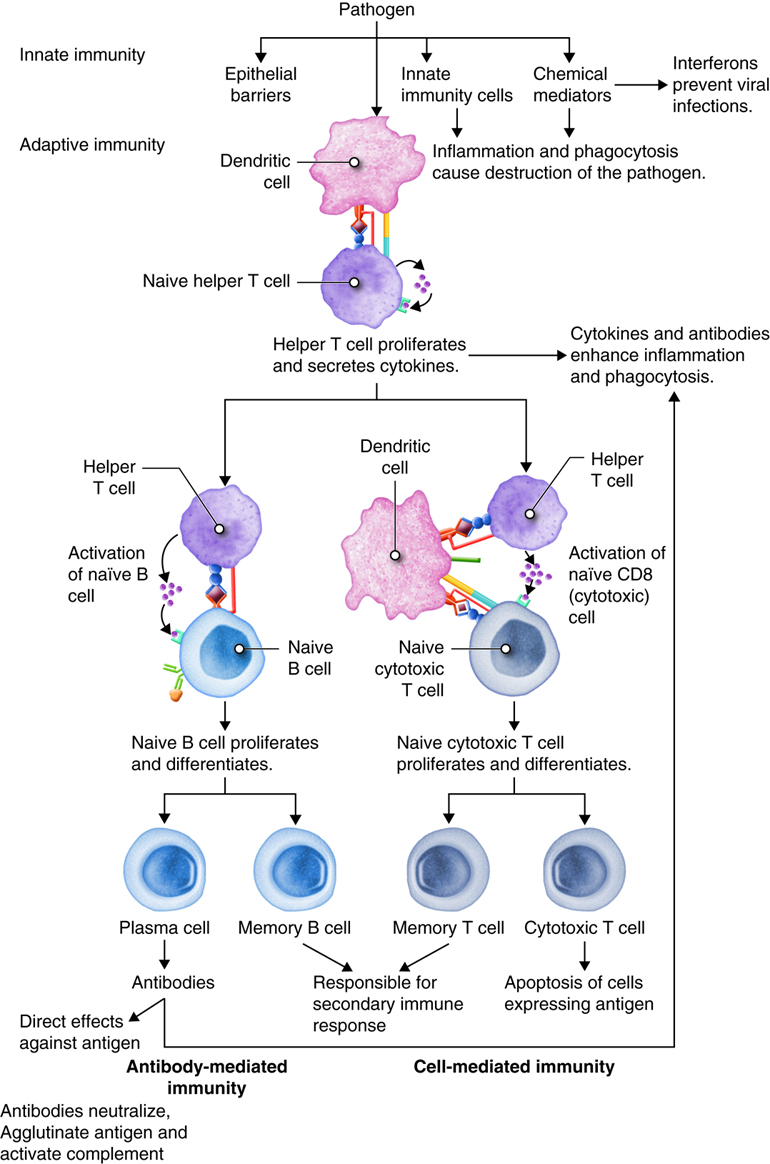7.2 Overview of Innate and Adaptive Immunity
kfalcone
Steps to the The Immune System Battle:
- The cellular immune response begins when a pathogen gets through the bodies physical and chemical barriers.
- If a pathogen gets past the hosts defenses it will attempt to infect the host and begin replicating itself. The subsequent battle between the germs and the body’s immune system will cause the symptoms of illness.
- The first immune cells to respond to the invading pathogen are the innate immune cells: mast cells, macrophages, natural killer cells, dendritic cells, monocytes, neutrophils, basophils, and eosinophils. These cells are always ready to fight off pathogens and work hard to destroy the foreign invaders.
- Actions of the innate immune system cells
- Dendritic Cells: Ingest pathogen and help activate the adaptive immune system by presenting their antigen to Helping T-Cells and killer T-Cells.
- Neutrophils: Migrate from the bloodstream to ingest and kill bacteria and fungi and recruit more immune cells.
- Macrophages: Known as the “big eaters”, they ingest pathogens and dead cells and help activate the adaptive immune system by presenting their antigen. They also recruit more immune cells.
- Mast Cells: launch inflammatory response and recruit macrophages and neutrophils.
- Natural Killer cells: Detect and kill tumor or virus infected cells.
- Basophils: Defend against parasites and contribute to inflammatory response.
- Eosinophils: Kill bacteria and parasites.
- The innate immune cells alert the whole body that there is a problem by activating the inflammatory response and initiating the adaptive immune system.
- The inflammatory response brings swelling, pain and higher temperature, which attracts more cells to the site of infection. This means more immune cells join the fight to destroy the pathogen.
- The innate immune cells provide important information to the adaptive immune cells to “train” the adaptive immune cells how to destroy the pathogen.
- Training the adaptive immune cells is done in two ways, by releasing cytokines and displaying the pathogens antigens.
- Cytokines are signals that tell cells what to do and where to go. Your body responds to threats in different ways depending on the cytokine signal released by your immune cells.
- The antigen is displayed when the innate immune cells capture and breakdown the invader.
- Together, the cytokines and antigens train individual adaptive immune cells to recognize and destroy specific patterns of each foreign invader.
- The Adaptive Immune System Cells
- Helper and killer T-Cells are activated after the Dendritic cells engulf the pathogen.
- When the helper T-Cells create B-Cells they are initiating the adaptive immune system.
- Antibodies, B Cells, are then produced that attach to the pathogen.
- The B Cells divide to produce plasma and memory cells.
- If the same pathogen invades again, the memory cells help the immune system activate much quicker.
- When the adaptive cells are “trained” how to fight a specific antigen, they remember how to fight it, thus the next time that this pathogen tries to infect you your adaptive immune cells will remember it and destroy it quickly.
- The ability of the immune system to remember previous pathogens is commonly called adaptive or acquired immunity and is the basis for vaccines.
- However, pathogens really want to live and they can be tricky. Some pathogens, including those that cause flu, strep throat, and malaria, can mutate and change the way they look to your immune system over time by changing their antigen markers thus disguising themselves marking it harder for your immune system to recognize the mutated germs even though you’ve been exposed to them before. This is why you can get sick from flu, strep throat, or COVID multiple times.

Next- 7.3.1 Basic Concepts of Antimicrobial Therapy
Media Attributions
- Lymph_42 © Open Learning Initiative is licensed under a CC BY (Attribution) license

